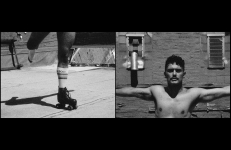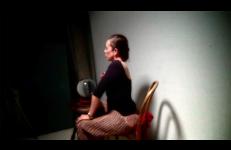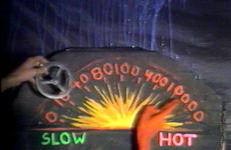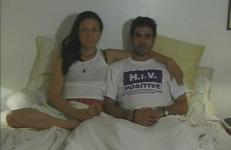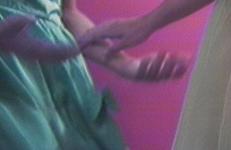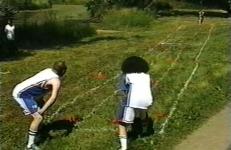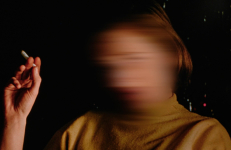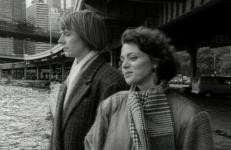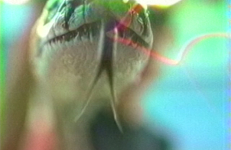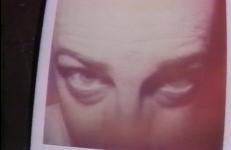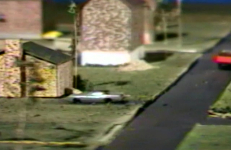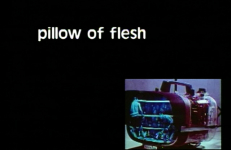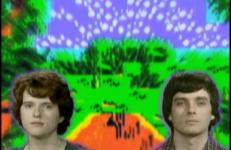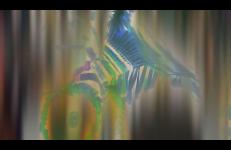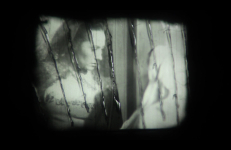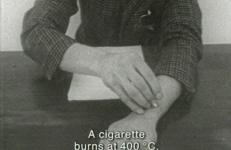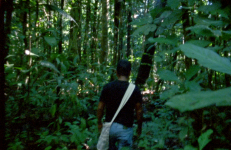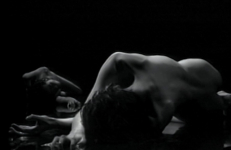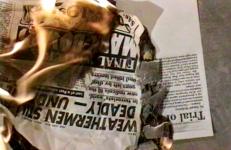A film titled Dance Movie (or, alternatively, Rollerskate) appears in many Warhol filmographies, but no work with this title has been found in the archive. The lost film, starring dancer Fred Herko, was shot in 1963. A year later, Herko leaped out of an open window while dancing to Mozart’s Coronation Mass in C Major. Inspired by descriptions of the missing film and the memoir of Herko’s best friend, the poet Diane Di Prima, Goddess of Speed poetically reimagines the last days of the young performer.
Death and Dying
Rebecca gazes into the crystal ball. It is afternoon in a Brooklyn neighborhood of industrial buildings. Rebecca has a way with words just as words have a way of seeking her out. The crystal ball intensifies this. The A train rumbles over the Manhattan Bridge. Rebecca gazes into the crystal ball. Nighttime in a suburban neighborhood of burnt out buildings. Words have a way with Rebecca just as Rebecca has a way of seeking them out. The crystal ball intensifies this.
"Oursler’s thematic concerns betray classic Freudian anxieties about sex and death. In Grand Mal, the hero takes a convoluted odyssey through a landscape of disturbing experiences. The video’s free association includes, "digressions about the difference between salt and sugar and a version of the creation myth that is both banal and terrifying."
— Christine Tamblyn, “Art Notes,” Scan (November/December 1981)
Habit is an autobiographical documentary that follows the current history of the AIDS epidemic along dual trajectories: the efforts of South Africa’s leading AIDS activist group, the Treatment Action Campaign, struggling to gain access to AIDS drugs and the daily routine of the videomaker, a veteran AIDS activist in the U.S. who has been living with AIDS for more than ten years.
There is no need to "sin" because Hell is here, just go to the window and peek out…. It’s next door and is on display in this movie.
… See the poet tumble down a flight of stairs as he avoids the clutches of a behemoth babe who practices witchcraft and carries plastic flowers.
Hey Bud revolves around the suicide of Bud Dwyer, a government official who killed himself before a television audience. Zando compares the suicide to a kind of pornographic sex act that plays upon the tension created between exhibitionist and voyeur. It forces viewers to take either an empathetic position vis-a-vis the exhibitionist, or to act as voyeur through release of the repressed desire to see the forbidden face of Death. The piece attempts to understand the power gained through exhibitionism, and how that power is lost through death.
High Five usually comes across as absurd and silly, and generally gets a laugh when shown. I appreciate this response and agree it is quite ridiculous on the surface. However few know the true dark meaning of the piece, which was my personal contribution to a ceremony commemorating the twentieth anniversary of my mother's suicide.
"Superimposing the stories of two women—the filmmaker’s late grandmother and the amateur filmmaker Joan Thurber Baldwin—Home When You Return explores the psychogeographies of mourning through a variety of modes, from documentary to melodrama. Emptied and put up for sale following its matriarch’s passing, the family home becomes the site of a winding tour through polymorphic representations of the past in media and memory." - NYFF Currents
With an amusing sense of drama, The Houses That Are Left illustrates Silver’s technique of building an obscure narrative into a complex net of miscellaneous texts and images. Unfolding throughout the tape is the story of two friends who come together to try to figure out how to live in the modern world while being besieged by militant messages from the dead.
The Hundred Videos is a project undertaken by prolific video artist Steve Reinke, including 100 video works made from 1989-1996. Discussing death, sex, the body, philosophy, and contemporary art, The Hundred Videos defines a unique style of video-essay for the end of the 20th Century.
"Each disquieting image breaks down into a pixel, each pithy phrase into a word, and Reinke's stream of video-thought continues apace. The corpse won't stop talking."
— Jon Davies, Images Festival: Spotlight Essay, April 2018
The Hundred Videos is a project undertaken by prolific video artist Steve Reinke, including 100 video works made from 1989-1996. Discussing death, sex, the body, philosophy, and contemporary art, The Hundred Videos defines a unique style of video-essay for the end of the 20th Century.
"Each disquieting image breaks down into a pixel, each pithy phrase into a word, and Reinke's stream of video-thought continues apace. The corpse won't stop talking."
— Jon Davies, Images Festival: Spotlight Essay, April 2018
The Hundred Videos is a project undertaken by prolific video artist Steve Reinke, including 100 video works made from 1989-1996. Discussing death, sex, the body, philosophy, and contemporary art, The Hundred Videos defines a unique style of video-essay for the end of the 20th Century.
"Each disquieting image breaks down into a pixel, each pithy phrase into a word, and Reinke's stream of video-thought continues apace. The corpse won't stop talking."
— Jon Davies, Images Festival: Spotlight Essay, April 2018
The Hundred Videos is a project undertaken by prolific video artist Steve Reinke, including 100 video works made from 1989-1996. Discussing death, sex, the body, philosophy, and contemporary art, The Hundred Videos defines a unique style of video-essay for the end of the 20th Century.
"Each disquieting image breaks down into a pixel, each pithy phrase into a word, and Reinke's stream of video-thought continues apace. The corpse won't stop talking."
— Jon Davies, Images Festival: Spotlight Essay, April 2018
The Hundred Videos is a project undertaken by prolific video artist Steve Reinke, including 100 video works made from 1989-1996. Discussing death, sex, the body, philosophy, and contemporary art, The Hundred Videos defines a unique style of video-essay for the end of the 20th Century.
"Each disquieting image breaks down into a pixel, each pithy phrase into a word, and Reinke's stream of video-thought continues apace. The corpse won't stop talking."
— Jon Davies, Images Festival: Spotlight Essay, April 2018
In an interview I did earlier this year for the Milan Game Video/Art exhibition, I deflected a question about the connection between Hymn of Reckoning and Reckoning 3, discouraging the idea that there was much of a link between the two videos, apart from their names and their use of video game material. Now that I’ve thought about it more, I can tease out more connections.
An elegy to Diane Burns on the shapes of mortality and being, and the forms the transcendent spirit takes while descending upon landscapes of life and death. A place for new mythologies to syncopate with deterritorialized movement and song, reifying old routes of reincarnation. Where resignation gives hope for another opportunity, another form, for a return to the vicissitudes of the living and all their refractions.
“I’m from Oklahoma I ain’t got no one to call my own.
If you will be my honey, I will be your sugar pie way hi ya
way ya hi ya way ya hi yo.”
I once read a story about the Tibetan Buddhist Master, Chogyam Trungpa Rimpoche in a book by death-teacher, Steven Levine. Trungpa went into his son's room and said to him, "I'm dying." And then he said to his son, "You are dying too." This story made a deep impression on me because death is the last taboo, the hidden boogey-man, the unspeakable. It was a beautiful lesson in impermanence this father gave his son.
A woman raises her voice and gives a painful and endless speech that with time becomes even more overwhelming, because her words are heartbreaking and permanent impressions in the collective memory, stabbing with words an old Mexican film, a celluloid that tears apart until its disappearance.
This title is also available on the compilation What Was Always Yours and Never Lost.
"When we show you pictures of napalm victims, you'll shut your eyes. You'll close your eyes to the pictures. Then you'll close them to the memory. And then you'll close your eyes to the facts." These words are spoken at the beginning of this agitprop film that can be viewed as a unique and remarkable development. Farocki refrains from making any sort of emotional appeal. His point of departure is the following: "When napalm is burning, it is too late to extinguish it. You have to fight napalm where it is produced: in the factories."
It's not my memory of it is a documentary about secrecy, memory, and documents. Mobilizing specific historical records as memories which flash up in moments of danger, the video addresses the expansion and intensification of secrecy practices in the current climate of heightened security. A former CIA source recounts his disappearance through shredded classified documents that were painstakingly reassembled by radical fundamentalist students in Iran in 1979.
It's not my memory of it is a documentary about secrecy, memory, and documents. Mobilizing specific historical records as memories which flash up in moments of danger, the video addresses the expansion and intensification of secrecy practices in the current climate of heightened security. A former CIA source recounts his disappearance through shredded classified documents that were painstakingly reassembled by radical fundamentalist students in Iran in 1979.
A voyage into the labyrinthine memories of a Uitoto man, who worked for the drug Lords in the Colombian Amazon back in the 80s. Following his path between the forest and the ruin of a Narco's mansion imitating the Carrington mansion in the soap opera Dynasty, the film unfolds the hallucinatory account of a near-death experience.
Lament is a collaboration with video artist James Byrne. Movement material is adapted from Eiko & Koma's 1984 performance work Elegy. Sound mix by Eiko & Koma.
Commissioned by the Walker Art Center, Minneapolis, MN and made possible with funds from the National Endowment for the Arts and the Jerome Foundation, St. Paul, MN. 1986, Eiko & Koma, James Byrne, Walker Art Center. Videographed July, 1985 at the Triplex Theatre, New York, NY. Edited in 1986.
A series of unnatural deaths and departures (almost all, of men) disrupts the lives of nine families sharing an apartment building in Jerusalem.
Letter to a missing woman, based partly on memories of someone who has been a political fugitive since 1983, combines documentary "evidence" and fiction in an imaginative reconstruction of public documents and private history. This is a quiet, obsessive piece addressing the human costs and repercussions of re-inventing oneself – one’s body, memories, and future – as a living piece of propaganda. The writer/narrator of this "crazy letter" is an unreliable one, a composite of half-truths, paranoid digressions, and feelings of loss.




